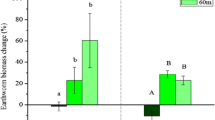Abstract.
Lead and zinc mine tailings from Guangdong, China were found to be toxic to two common species of the earthworm Pheretima, unless the spoil was diluted by at least 20% with an artificial uncontaminated soil. With different soil dilutions, there were significant differences in mortality, growth and Zn uptake between the two species. Zinc and arsenic were principally responsible for the toxicity of the tailings. LC50 values for Zn, Pb, Cu and As for Pheretima were similar to those reported in the literature for Eisenia fetida. Following inoculation with the earthworms, spoil pH, EC and available metals increased; available-Pb and -Zn concentrations increased by up to 48.2% and 24.8% respectively. The findings suggest that earthworms may play an important role in reclamation of mining spoils to achieve a healthy soil supporting sustainable vegetation. Potentially increased toxicity of metals to plants and animals, through increased bioavailability in the presence of earthworms, is discussed in the context of their role in modifying the efficiency of phytoremediation treatments.
Similar content being viewed by others
Author information
Authors and Affiliations
Additional information
Electronic Publication
Rights and permissions
About this article
Cite this article
Ma, .Y., Dickinson, .N. & Wong, .M. Toxicity of Pb/Zn mine tailings to the earthworm Pheretima and the effects of burrowing on metal availability. Biol Fertil Soils 36, 79–86 (2002). https://doi.org/10.1007/s00374-002-0506-0
Received:
Accepted:
Issue Date:
DOI: https://doi.org/10.1007/s00374-002-0506-0




